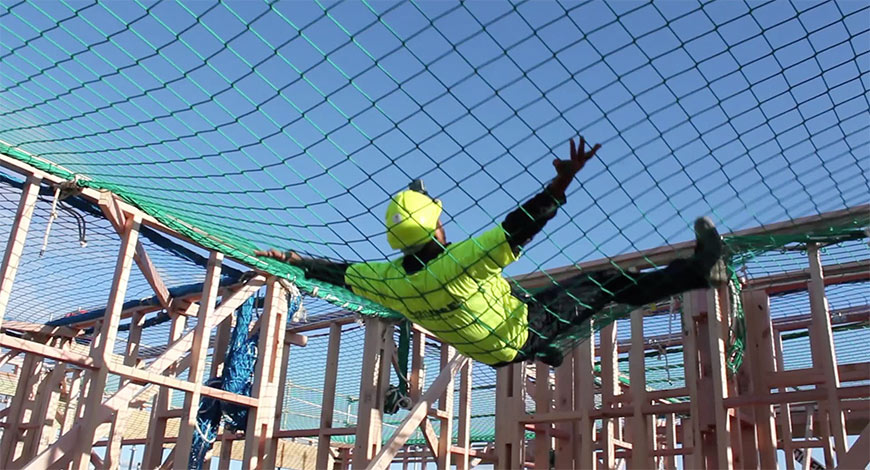
Health & Safety Work Reform
Incoming Health and Safety at Work Reform – Get ready for a change for the better!
Last year the Government announced changes to a range of outdated, complex and incomplete health and safety requirements. New health and safety regulations are to be developed that will provide more clarity and certainty for businesses and better safety and health for workers.
These proposed changes will impact all aspects of the construction industry, but with particular focus on the risks associated with working at height and the need to ensure the use of fully compliant fall arrest systems, fall arrest safety equipment and fall protection measures , the team at Safety Nets NZ is ensuring that we are up to speed with latest developments.
From 2008 to 2019, on average 54 people a year died at work from injuries involving plant (e.g. machines, vehicles and equipment) and structures (e.g. scaffolding and excavations). That’s three-quarters of all work-related injury deaths. New Zealand’s work-related acute fatalities are high by international standards, approximately twice that of Australia and four times the rate of the United Kingdom.
During the public consultation, many stakeholders supported changing the regulations that apply to plant and structures and wanted greater clarity and certainty. The changes have been designed to ensure the rules are clear, effective, flexible, durable and proportionate, making it easier for businesses to manage risks, and better ensure people come home from work safe and healthy.
The changes will create better regulations and release business from the burden of not being clear of what’s required of them.
The Government will release a draft of the new plant and structures regulations this year and people will have the chance to comment on how the changes are best implemented during that process.
Plant and structures are everywhere – they are used in a wide range sectors and for many different purposes at work. They are involved in 79% of work related injury fatalities. Risks associated with plant and structures kill and seriously injure people every day.
Overview
‘Plant’ on construction sites includes any machinery, vehicles, equipment, or tools used for construction work, such as cranes and hoists, elevated work platforms, cutting and grinding equipment, compressors, and earthmoving and excavation machinery.
The new regulations will modernise and bolster the existing regulations by introducing new requirements for:
- specified processes for determining guarding for each plant;
- safe installation, maintenance, cleaning and storage of plant;
- operational controls, emergency stops, and warning devices to be safely designed;
- specific steps to avoid unsafe use or alterations;
- presence-sensing safeguarding systems to be monitored, and thorough record keeping of testing, inspection, maintenance and alterations; and
- additional design and operational requirements for plant that lifts or suspends loads, and for lasers.
Further regulations will apply to high risk plant, which includes equipment or machinery such as cranes and pressure equipment. The requirements include suppliers and operators ensuring that the designs for such plant are verified by qualified engineers and registered in a central register (operated by WorkSafe).
Upstream businesses
The new regulations aim to address plant safety throughout different stages of the supply chain, making plant entering New Zealand workplaces safer and therefore reducing harm to workers. This is achieved by requiring designers, suppliers, importers, and manufacturers of plant (as applicable) to:
- provide critical safety information across the supply chain;
- manage risks and hazards identified when designing, manufacturing, supply or importing plant;
- share any faults in second-hand plant to the person being supplied the plant;
- have guarding and safety features to meet the requirements placed on businesses that use the plant; and
- request or order new designs of plant to provide designers any information about reasonably foreseeable risks and hazards at the workplace where such plant or structure will be used.
Working at height
The existing working at height requirements will be updated, clarified and simplified so that they are more flexible to the circumstances and proportionate to the risk, including:
- a requirement for businesses to apply a prescribed risk management process (as defined in Part 1, Health and Safety at Work (General Risk and Workplace Management) Regulations 2016) to all work at height;
- a requirement for business to follow a hierarchy of controls for construction work; and
- licensing and qualifications for scaffolding construction and inspections will be modernised to reflect current industry practice.
From the company’s point of view, this aspect of the new regulations is most significant, as it will impact the installation of our fall arrest and fall protection systems.
Excavation work
The new regulations will also bolster the provisions relating to excavation work by requiring:
- compliance with a prescribed risk management process;
- PCBUs with management or control of work sites to check for underground services to address the risk of harm and economic disruption from line strikes;
- excavation work greater than 1.5 meters deep, existing controls for shoring, and fencing, will be retained and revised as well as requirements for notifying WorkSafe; and
- strengthened competency for determining whether shoring is required to prevent ground collapse.
Offences
Offences and penalties corresponding with these proposed regulations will be proportionate to the potential harm, and consistent with the existing offences and penalties under the Act.
What’s next?
A draft of the new regulations is expected to be released by the Government soon. The public will then have a chance to comment on how the changes would be best implemented, with the final regulations expected to be in place by late 2022.
As we all know, the construction sectors has always had issues with regard to accidents/injuries/fatalities, and any means of assessment / review of current systems and practices that leads to improvement in work place safety needs to be encouraged.
We look forward to seeing what comes out of the public consultation following release of the draft report, and will update further when more details are knows.
Until next time
10 2022
